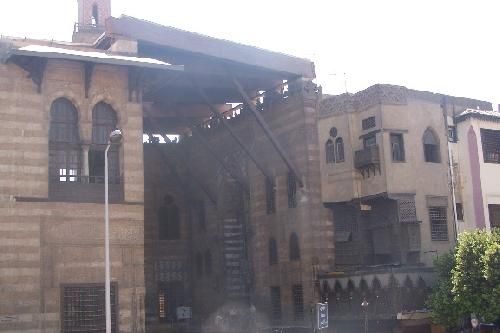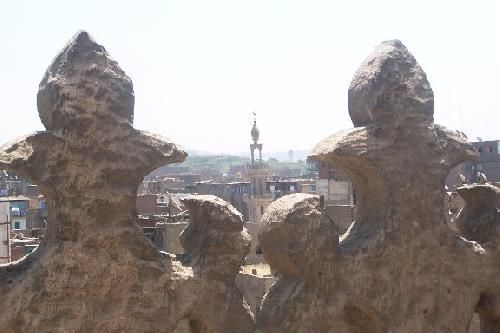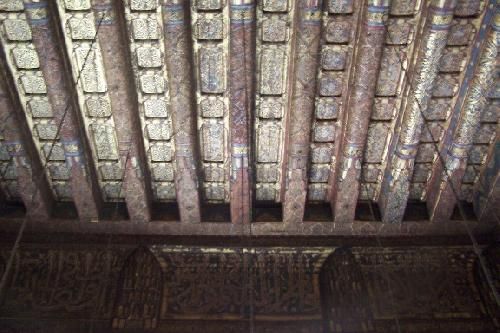
 The Ghuri Complex lies in El-Ghuriya nearby the Intersection of El Muiz Le Din Allah Street and El-Azhar Mosque. It was established by Sultan Qunsuh El-Ghuri, the last Mamluk Sultan who assumed the power for along period. Some historians say that he was a tyrant and dictator leader and he tortured many people and killed a lot of those who opposed him. Yet, other historians assure that he was a man with a refined cultural taste and a kind person who provides a number of Sufis with all what they need. El-Ghuri died after the defeat of Emir Khayrbak in the battle of Aleppo out of a heart attack. A)
The Ghuri Complex lies in El-Ghuriya nearby the Intersection of El Muiz Le Din Allah Street and El-Azhar Mosque. It was established by Sultan Qunsuh El-Ghuri, the last Mamluk Sultan who assumed the power for along period. Some historians say that he was a tyrant and dictator leader and he tortured many people and killed a lot of those who opposed him. Yet, other historians assure that he was a man with a refined cultural taste and a kind person who provides a number of Sufis with all what they need. El-Ghuri died after the defeat of Emir Khayrbak in the battle of Aleppo out of a heart attack. A)
The Mosque-Madrasa: The Mosque-Madrasa of El-Ghuri lies on the left side of the Complex and is distinguished by its flowering Mamluk decorations. This Mosque-Madrasa was erected to commemorate El-Adha Feast or the Sacrifice Feast and its inauguration party was attended by a large number of the Statesmen and noblemen, on the top of them was the Abbasid Caliph El-Mustamsik.

The original Minaret of the mosque has a square form that differs from the style used at that time. It was supported with four pinnacles finely ornamented with colorful tiles that were replaced with five pinnacles later on. The interior plan of the building consists of a courtyard surrounded by four aisles and supported with marble-inlaid Panels and finely ornamented with colored geometric items. There are also some windows that enable the person from seeing the things outside the mosque.

The Madrasa was surrounded by a number of finely ornamented stalls. B)The Mausoleum and Sabil-Kuttab Facing the Mosque stands the Mausoleum and Sabil-Kuttab of El-Ghuri that coast him about 100000 dinars for erecting it. It was surmounted by a brick dome with green-tile ornate, but after being unsuccessfully restored for several times it was revealed.The present tomb is covered with a wooden ceiling that traces back to the late 18th century.
The walls of the tomb were ornamented with beautiful arabesque patterns that do not exist now. From the entrance of the room, one finds a corridor with the mausoleum on its right and another room on its left. Sultan El-Ghuri is not buried in the tomb since he died in mysterious conditions and his body was not found. Yet the mausoleum involves the cenotaph of his son Sultan El-Nasir Mohammed, his daughter, his mother and Sultan Tumanbay who came to power after him. This mausoleum is used now as a cultural center that gives educational lectures for adults and it includes a library. The room on the left side of the corridor including a Mihrab was a part of the Khanqah of El-Ghuri and it was dedicated for the Sufis for performing Dhikr there.
This place was restored to be a beautiful theatre for popular theatrical performances later on. One can reach the Sabil-Kuttab of El-Ghuri through a path from the theatre. It is worth visiting for its floor that is beautifully decorated with marble patterns. The complex includes also a Maqaad that can be reached through a side door in the El-Azhar Street. The complex is distinguished from any other monument at that time by its way of arrangement, since there is a space that separates each part of the complex from the other and these spaces were used as small shops to keep the area of the complex alive and inhabited with people.

The street between the mosque and the mausoleum was once covered, but now it is an ordinary street but it is still a commercial area that is crowded with people. Tourists usually prefer shopping for handmade copper plates, brass works, tent making works , accessories and Alabaster statues from this local market. The whole complex was destroyed as an impact of 1992 earthquake. But in 2000, the mosque of Sultan El-Ghuri was restored and the small shops on its sides were removed. The mosque was ornamented with handsome grungy gray marble items.
